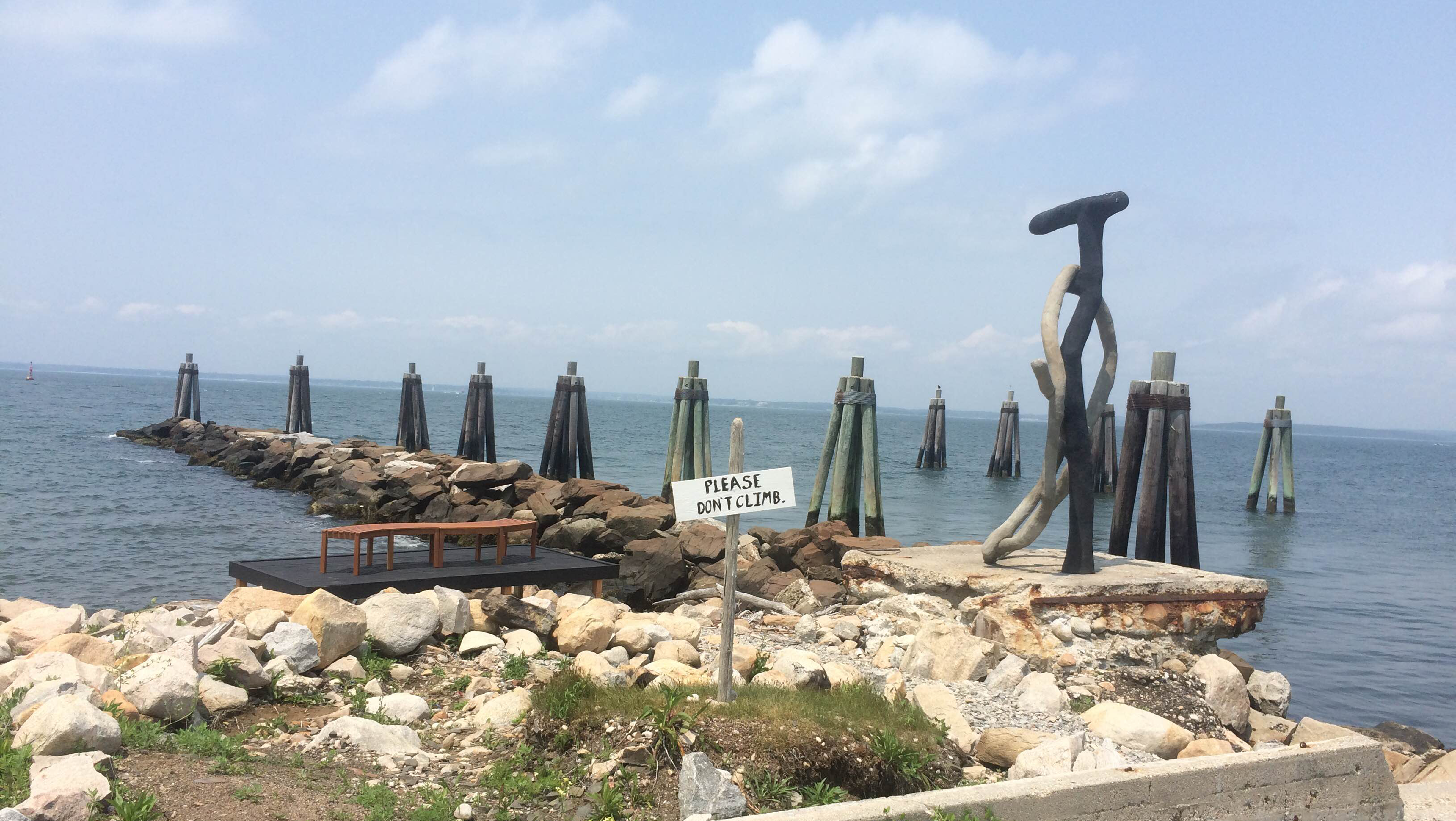May 1–Dec 31, 2015
Daphne Fitzpatrick [2]
That Might Be a Wise Crack (But I Doubt It)
tinted concrete, wire frame

About
A kazoo is sounding on the ferry to Fisher’s Island. The boat sprayed my poem somewhere between the Connecticut and New York state lines, between Eileen Myles and Walt Whitman, swashed it across the bowed breast of crisp white linen. As a kid, Daphne Fitzpatrick slipped on a banana peel and was desperate for a “bald-haired wig.” That might be a wise crack, but I doubt it.
Fitzpatrick’s work could be characterized as absurdist. Playwrights like Alfred Jarry and Eugene Ionesco come to mind—the “merdre” that caused a riot in Théâtre de L’Oeuvre in 1896. Language falls apart as it hits against her objects, which are simultaneously riotous and mundane. In viewing Fitzpatrick’s sculptural and photographic work, I am reminded that reason never cleanly aligns to begin with. It is not that nothing makes sense, or that objects randomly stack up, rather Fitzpatrick’s work calls into question the manner in which sense is organized. Logic is deemed logical by its own logic. Like Martin Kippenberger’s lampposts that appear askew, stitched across the gallery wall, or with two lamppost feet that come together to form a city’s torso, That Might be a Wise Crack, but I Doubt It undoes the grounding sobriety of sense. Just as the iconic drunk needs a lamppost to hold himself up, to set the landscape in a straighter perspective, so too a limp cement pretzel draped on the shoulder of an erect old-timey crutch makes a certain sense, even as it does away with the steady ground of reason.
In the 1929 Marx brothers film, The Cocoanuts, Groucho Marx plays the hotel owner with a sea of bellboy rockettes. When they approach Groucho en masse to demand fair wages, he tells them, “Money will never make you happy, and happy will never make you money. That might be a wise crack, but I doubt it.” In the wise crack that appears on the ferry docks of Fishers Island, the linguistic turns sculptural, flesh becomes cement leaning out over the Atlantic, where happy makes you something, but it sure ain’t money. The bellhops groan in protest, but Groucho continues, “I’ll put extra blankets free in all your rooms, there’ll be no cover charge!” This is the logic of the joke: the rule of order is undercut by the collision of words whose meanings cannot be held apart. Blankets creep into the cover charge and the Marx brothers, with their Vaudevillian sensibilities, poke holes in the proprietary logic. America was not founded on the solid ground of truth and freedom, so why not call it a stage; there is humor in the reveal. As Wayne Koestenbaum writes of Harpo Marx, his “gestures obey a mysterious nonlogic of mere adjacency. The schtick’s fragments stack up like cubes or buttons—impropriety’s rosary-beads. His performances, like the ocean’s, are abstract. We observe the ebb, but we don’t expect an explanation.” The adjacency of objects, like the ocean, takes us on a ride, on a journey whose boat is a slab of concrete. Sedimenting the everyday in stucco Portland cement, the crutch and the pretzel become friends hanging out at the beach, back again for another summer, salty and defiant. The horizon line moves as the pals stay put, afloat, askew, standing tall.
- Katherine Brewer Ball
Artist
Bio
Daphne Fitzpatrick was born in Long Island, New York, in 1964. Selected exhibitions include A Roll in the Hay at Bellwether in New York (2007); Shared Women at Los Angeles Contemporary Exhibitions (LACE) in Los Angeles (2007); Little Triggers at Cohan and Leslie in New York (2003); Private View: Daphne Fitzpatrick/Nancy Shaver/Amy Sillman/Kara Walker at Brent Sikkema in New York (2001). Daphne Fitzpatrick lives and works in Brooklyn.
Daphne Fitzpatrick’s practice is rooted in the historical and aesthetic concerns of the flâneur, the 19th century literary figure traditionally pictured as a dandy gentleman wandering the city streets. The flâneur defines itself in opposition to the speed, production, and values of modern urban life, stubbornly engaged in cultivating a refined aesthetic position dedicated to appropriating the overlooked and marginalized aspects of the urban landscape. For Fitzpatrick, the flâneur’s contemporary stance is romantically symbolized with an oversized photograph of worn high-top sneakers—the mark of contemporary urban travels. Fitzpatrick conflates a hobo sensibility with the care and attention of fine craftsmanship. Whether appropriated, foraged, or recreated, each of her works connects back to experiences within an ever-changing urban environment. Fitzpatrick combines appropriated images, found objects, photographs, sculpture, and video, building complex narratives littered with banal joke shop humor, sexual puns and perverse poetry. As Helen Molesworth wrote, Daphne Fitzpatrick is “reimagining…the commodity as a kind of Surrealist-inflected game piece…[she] uses the castoffs of spectacle culture to create delicate, Lilliputian tableaux inflected with visual puns”.